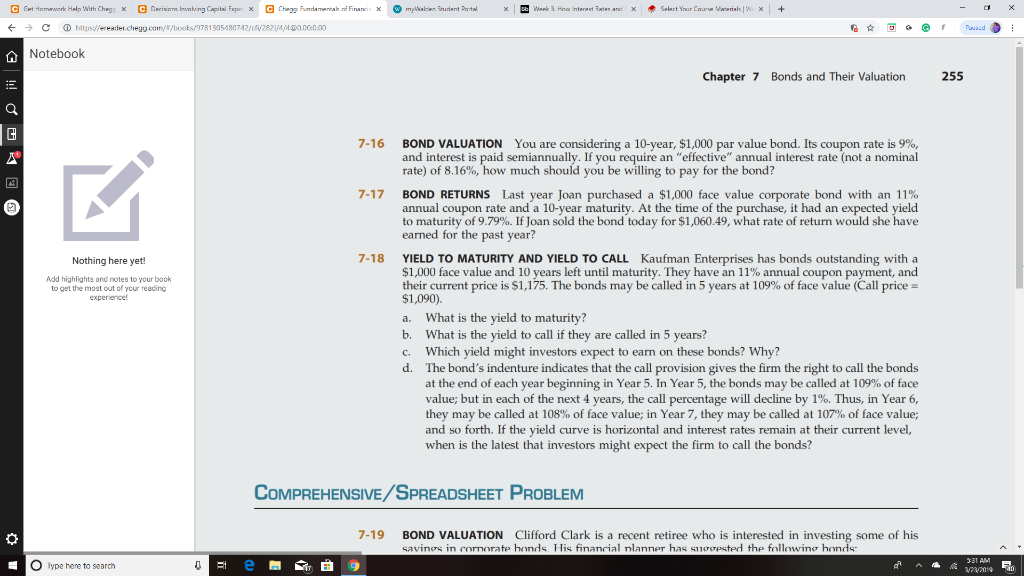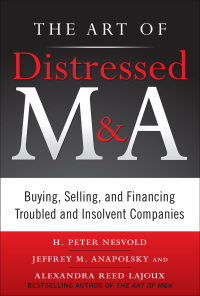 Decisions involving capital expenditures often require managers to weigh the costs and benefits of different options related to the financing of a project. For instance, deciding when to call a bond before maturity due to changing interest rates can lower the overall cost of a project significantly through refinancing. So, it is important to be able to understand the real interest rate being paid out to your bondholders (yield) at any given time.
Decisions involving capital expenditures often require managers to weigh the costs and benefits of different options related to the financing of a project. For instance, deciding when to call a bond before maturity due to changing interest rates can lower the overall cost of a project significantly through refinancing. So, it is important to be able to understand the real interest rate being paid out to your bondholders (yield) at any given time.
For this Assignment, review the information presented in Problem 7-18 on page 255 of your course text. You will utilize the information in this week's readings and media to make a recommendation with regard to when to call a bond.
- Prepare a spreadsheet using Excel or a similar program in which you compute the items listed in parts a, b, and d. Be sure to compute the Yield-to-Maturity (YTM) and Yield-to-Call (YTC) for each of years 5, 6, 7, 8, and 9.
- Utilizing Word, prepare a written report to your finance director:
- Include a detailed explanation of the conclusion you reached concerning whether or not to call the bond before maturity.
- If your recommendation is to call the bond early, explain when to call the bond and your rationale.
- Discuss the advantages and disadvantages of using a long-term loan instead of a bond.
https://ereade.chegg com/r/book/9781 305480742/tfy282UA/4@oonoo Notebook Chapter 7 Bonds and Their Valuation 255 7-16 BOND VALUATION and interest is paid semiannually. If you require an "effective" annual interest rate (not a nominal rate) of 8.16%, how much should you be willing to pay for the bond? You are considering a 10-year, $1,000 par value bond. Its coupon rate is 9%, 7-17 BOND RETURNS Last year Joan purchased a $1,000 face value corporate bond with an 11% annual coupon rate and a 10-year maturity. At the time of the purchase, it had an expected to maturity of 9.79%. If Joan sold the bond today for $1,060.49, what rate of return would she have earned for the past year? 7-18 YIELD TO MATURITY AND YIELD TO CALL $1,000 face value and 10 years left until maturity. They have an 11% annual coupon payment, and their current price is $1,175. The bonds may be called in 5 years at 109% of face value (Call price- $1,090). Nothing here yet! Kaufman Enterprises has bonds outstanding with a Add highlights and notes to your book to get the most out of ycur reading What is the yield to maturity? What is the yield to call if they are called in 5 years? Which yield might investors expect to earn on these bonds? Why? The bond's indenture indicates that the call provision gives the firm the right to call the bonds at the end of each year beginning in Year 5, in Year 5, the bonds may be called at 109% of face value; but in each of the next 4 years, the call percentage will decline by 1%. Thus, in Year 6, they may be called at 108% of face value; in Year 7, they may be called at 107% of face value; and so forth. If the yield curve is horizontal and interest rates remain at their current level, when is the latest that investors might expect the firm to call the bonds a. b. c. d. COMPREHENSIVE/SPREADSHEET PROBLEM 7-19 BOND VALUATION Clifford Clark is a recent retiree who is interested in inv savines in cornorate honds His financial nlanner has spted the follewwing some of his O lype here to search https://ereade.chegg com/r/book/9781 305480742/tfy282UA/4@oonoo Notebook Chapter 7 Bonds and Their Valuation 255 7-16 BOND VALUATION and interest is paid semiannually. If you require an "effective" annual interest rate (not a nominal rate) of 8.16%, how much should you be willing to pay for the bond? You are considering a 10-year, $1,000 par value bond. Its coupon rate is 9%, 7-17 BOND RETURNS Last year Joan purchased a $1,000 face value corporate bond with an 11% annual coupon rate and a 10-year maturity. At the time of the purchase, it had an expected to maturity of 9.79%. If Joan sold the bond today for $1,060.49, what rate of return would she have earned for the past year? 7-18 YIELD TO MATURITY AND YIELD TO CALL $1,000 face value and 10 years left until maturity. They have an 11% annual coupon payment, and their current price is $1,175. The bonds may be called in 5 years at 109% of face value (Call price- $1,090). Nothing here yet! Kaufman Enterprises has bonds outstanding with a Add highlights and notes to your book to get the most out of ycur reading What is the yield to maturity? What is the yield to call if they are called in 5 years? Which yield might investors expect to earn on these bonds? Why? The bond's indenture indicates that the call provision gives the firm the right to call the bonds at the end of each year beginning in Year 5, in Year 5, the bonds may be called at 109% of face value; but in each of the next 4 years, the call percentage will decline by 1%. Thus, in Year 6, they may be called at 108% of face value; in Year 7, they may be called at 107% of face value; and so forth. If the yield curve is horizontal and interest rates remain at their current level, when is the latest that investors might expect the firm to call the bonds a. b. c. d. COMPREHENSIVE/SPREADSHEET PROBLEM 7-19 BOND VALUATION Clifford Clark is a recent retiree who is interested in inv savines in cornorate honds His financial nlanner has spted the follewwing some of his O lype here to search
 Decisions involving capital expenditures often require managers to weigh the costs and benefits of different options related to the financing of a project. For instance, deciding when to call a bond before maturity due to changing interest rates can lower the overall cost of a project significantly through refinancing. So, it is important to be able to understand the real interest rate being paid out to your bondholders (yield) at any given time.
Decisions involving capital expenditures often require managers to weigh the costs and benefits of different options related to the financing of a project. For instance, deciding when to call a bond before maturity due to changing interest rates can lower the overall cost of a project significantly through refinancing. So, it is important to be able to understand the real interest rate being paid out to your bondholders (yield) at any given time.





